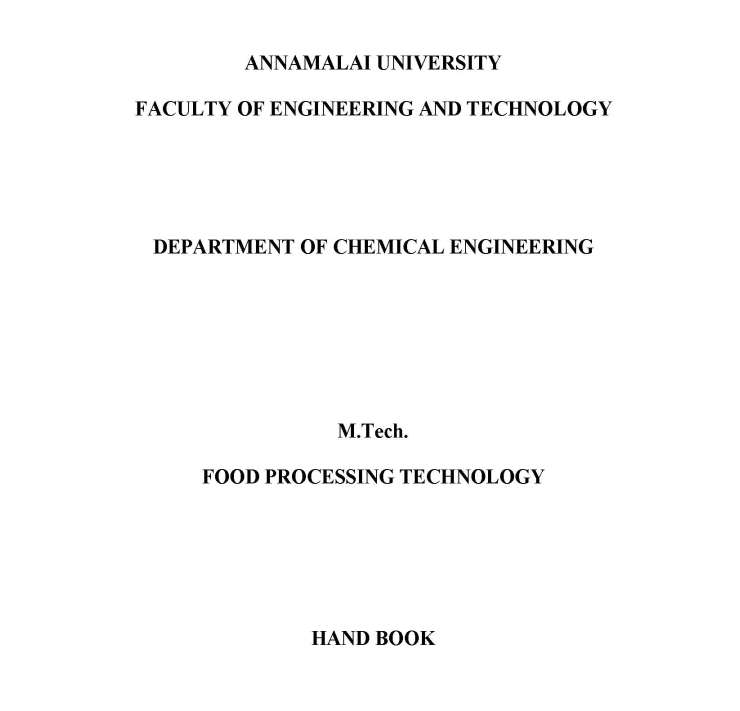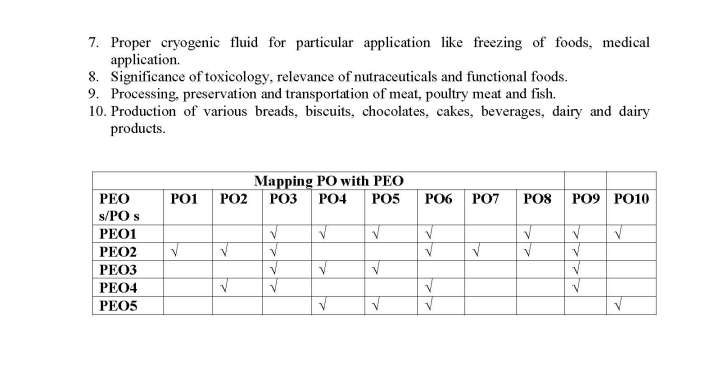|
#3
19th May 2020, 02:21 PM
| |||
| |||
| Re: Annamalai University Syllabus for Mtech
The syllabus for M. Tech. Food Processing Technology Program offered by Faculty of Engineering and Technology Department of Chemical Engineering of Annamalai University is as follows: FPTC101 FOOD CHEMISTRY AND MICROBIOLOGY COURSE OBJECTIVES: • To learn about the characteristics and compositions of foods. • To study the importance and significance of microorganisms related to food. Carbohydrates:Monosaccharides,Oligosaccharides,Pol ysaccharides,Starch,Cellulose,Guar and Locust Bean Gum, Xanthan, Carrageenans, Algins, Pectins, Gum Arabica and Dietary fiber. Lipids: Classification, physical aspects, chemical aspects, chemistry of fats and oil processing, role of food lipids in flavor, physiological effects of Lipids. Proteins: Physiochemical properties of amino acids, protein structure, protein denaturation, functional properties of proteins, nutritional properties of proteins, processing induced physical and chemical changes of protein. Food colorants: pigments in animal and plant tissues. Flavors: Taste and nonspecific saporous sensations, vegetable, fruit and spice flavor. Food additives: Acid, bases, buffer systems, chelating agent, antioxidant, antimicrobial agent, sweeteners, fat replacers and Mastigatory substances. Importance and significance of microorganisms in food science Micro-organisms importance in food – Factors affecting the growth of micro organisms in food – Intrinsic and Extrinsic parameters that affect microbial growth Food spoilage: characteristic features, dynamics and significance of spoilage of different groups of foods – Cereal and cereal products, vegetables and fruits, meat poultry and sea foods, milk and milk products, packed and canned foods. Food borne diseases: Bacterial food borne diseases ( Staphylococcal intoxification, Botulism, Salmonellosis, Shigellosis, Enteropathogenic Escherichia Coli Diarrhoea, Clostridium Perfringens gastroenteritis, Bacillus cereus Gastroenteritics) Food Borne Viral Pathogens (Norwalk virus, Norovirus, Reovirus, Rotavirus, Astrovirus, Adenovirus, Parvovirus, Hepatitis A Virus) Food Borne Animal Parasites Protozoa – Giardiasis, Amebiasis, Toxoplasmosis, Sarcocystosis, Crypotosporiodiosis. Cysticercosis/Taeniasis. Roundworm – Trichinosis, Anisakiasis. Mycotoxins: Aflatoxicosis, Deoxyni valenol Mycotoxicosis, Ergotism. REFERENCES: 1. Beltz, H.D. 2005. “Food Chemistry”. Springer Verlag. 2. Fennema, O.R, 2006, Food Chemistry, Academic Press. 3. Meyer, L.H. 1987. “Food Chemistry”. CBS publishers and Distributors, New Delhi 4. Potter, N.N. and Hotchikiss, J.H. 2006, “Food Sciences”, Fifth edition, CBS publishers and Distributors, New Delhi. 5. Frazier, W.C. 2007. “Food Microbiology”, Mc Graw Hill Inc. 4th Edition. 6. Pelezar, M.I. and Reid, R.D. 2007. “Microbiology” McGraw Hill Book Company, New York, 5th Edition. 7. James, M.J. 2000. “Modern Food Microbiology”, 2nd Edition. CBS Publisher 8. Adams, M.R. and M.G. Moss 2009. “Food Microbiology”, 1st Edition, New Age International (P) Ltd. 9. Doyle, P., Bonehat, L.R. and Mantville, T.J. 2010. “Food Microbiology, Fundamentals and Frontiers”, ASM Press, Washington DC 10. Fennema, O.R.2006. Food Chemistry. Marcel Dekker. Syllabus M. Tech. Food Processing Technology Annamalai University     |